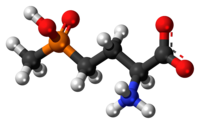
Photo from wikipedia
Two enantiomers of glufosinate were separated under reverse-phase conditions on a chiral crown stationary phase (CROWNPAK CR(+)). An efficient and reliable chiral analytical method was developed to determine the glufosinate… Click to show full abstract
Two enantiomers of glufosinate were separated under reverse-phase conditions on a chiral crown stationary phase (CROWNPAK CR(+)). An efficient and reliable chiral analytical method was developed to determine the glufosinate enantiomers and two metabolites in soil and water samples using high-performance liquid chromatography-high resolution mass spectrometry (HPLC-HRMS). The linearities of the matrix-matched calibration curves in five water and four soil samples were good, with a correlation coefficient R2>0.998, and the mean recoveries were 85.2%-100.4%, with relative standard deviations of 1.0%-7.1%. L-glufosinate was degraded faster than D-glufosinate in four nonsterile natural soil and two nonsterile natural water samples. The degradation half-lives of the enantiomers ranged from 3.4 to 33.0 d in the soil samples, but glufosinate was stable in the five water samples, less than 22% of the applied substance degraded at the end of the experiment (100 days). Degradation in sterile soil was not enantioselective. The two enantiomers were configurationally stable in the four soil and five water samples. In most cases of glufosinate degradation in soils, the percentage of 3-methylphosphinicopropionic in relation to the parent was higher than that of N-acetyl-glufosinate. L-glufosinate was preferentially degraded in the four soils, and the formation of 3-methylphosphinicopropionic acid and N-acetyl-glufosinate was enantiomer-dependent.
Journal Title: Journal of agricultural and food chemistry
Year Published: 2019
Link to full text (if available)
Share on Social Media: Sign Up to like & get
recommendations!